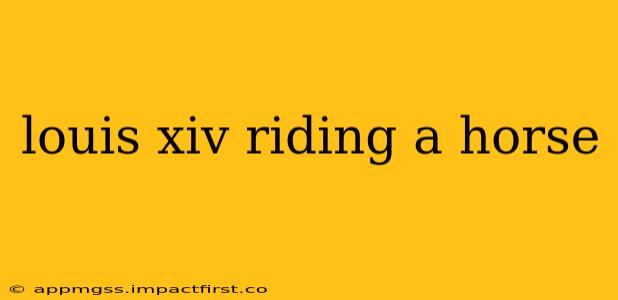Louis XIV, the "Sun King," reigned over France for an astonishing 72 years, leaving an indelible mark on French history, culture, and art. His image, often portrayed in majestic settings, frequently included depictions of him riding a horse. These weren't merely symbolic representations; horsemanship was a crucial aspect of his royal persona, reflecting power, skill, and the idealized image of a monarch. This article delves into the significance of Louis XIV riding a horse, exploring the symbolism, the artistic representations, and the historical context surrounding this iconic image.
Why Was Horsemanship Important for Louis XIV?
For a king, especially in the 17th century, horsemanship wasn't merely a hobby; it was a vital part of his public image. It demonstrated physical prowess, strength, and control – qualities essential for a ruler. The ability to skillfully manage a horse symbolized the king's ability to manage his kingdom. Furthermore, hunting, a pastime intrinsically linked to horseback riding, provided opportunities for the king to showcase his virility and dominance, further solidifying his regal authority. These equestrian displays were carefully choreographed events, often witnessed by courtiers and the public, serving as powerful statements of royal power.
What Symbolism Is Conveyed in Images of Louis XIV on Horseback?
Depictions of Louis XIV riding a horse often carry significant symbolic weight. The horse itself represents power, strength, and control – qualities directly associated with the king. The artist's choice of horse breed, its posture, and the overall composition of the painting or sculpture all contribute to the intended message. Often, the majestic setting, perhaps a grand landscape or a carefully arranged royal hunt, further enhances the image of the king's dominance and control over his domain. The horse, therefore, becomes an extension of the king's authority, a visual metaphor for his power and influence.
How Were These Images Created and by Whom?
Many prominent artists of the era immortalized Louis XIV on horseback. Painters like Hyacinthe Rigaud and Charles Le Brun meticulously crafted portraits that emphasized the king's regal bearing and his mastery over the horse. These weren't simply realistic depictions; they were carefully constructed images designed to project a specific image of the monarch – powerful, majestic, and divinely appointed. The level of detail, the careful rendering of both horse and rider, speaks volumes about the importance placed on accurately reflecting the king's image and authority.
What Role Did These Images Play in Propaganda?
The images of Louis XIV riding a horse played a crucial role in royal propaganda. They were designed to reinforce the king's image as a strong, capable, and divinely ordained ruler. These carefully crafted portraits and sculptures were strategically distributed throughout the kingdom, reinforcing the king's authority and legitimacy. By visually associating Louis XIV with strength and power, these images helped to solidify his position as the absolute monarch and maintain the stability of the French state.
Did Louis XIV Actually Enjoy Horseback Riding?
Historical accounts suggest that Louis XIV did indeed enjoy horseback riding and hunting. While the depictions often emphasized the regal aspect, they also reflected a genuine interest in the activity. His participation in royal hunts was not only a symbolic display of power but also a personal enjoyment. The carefully constructed images, therefore, weren't solely tools of propaganda; they also offered a glimpse into the king's personal interests and his relationship with the equestrian world.
This exploration of Louis XIV riding a horse reveals far more than just a king on a steed. It unveils a complex interplay of power, symbolism, art, and propaganda, providing a fascinating glimpse into the life and reign of one of history's most influential monarchs. The enduring images serve as powerful reminders of the importance of carefully curated royal imagery in shaping public perception and consolidating power during the 17th century.
